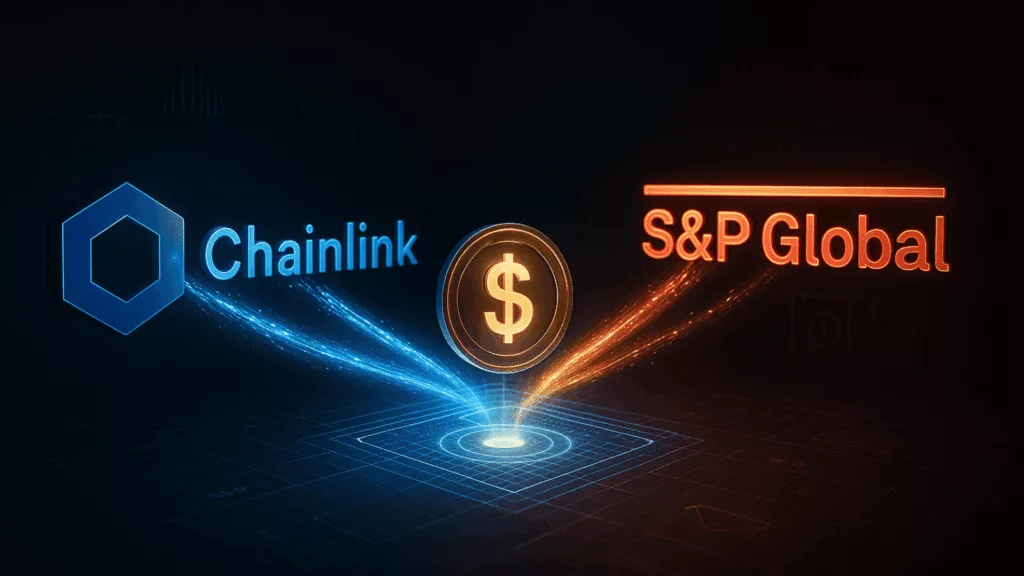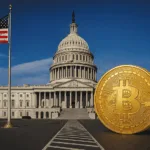- S&P Global Ratings partners with Chainlink to deliver real-time, onchain stablecoin risk profiles for financial institutions.
- Stablecoin Stability Assessments (SSAs) debut on Ethereum’s Base network, offering risk scores from 1 (very strong) to 5 (weak) based on peg stability.
- Partnership strengthens TradFi–DeFi convergence, enabling regulated institutions to access blockchain-native data securely and transparently.
In a landmark move bridging traditional finance (TradFi) and decentralized finance (DeFi), S&P Global Ratings has partnered with blockchain oracle provider Chainlink to bring its Stablecoin Stability Assessments (SSAs) directly onchain.
The initiative enables banks, asset managers, and other financial institutions to evaluate the peg stability of stablecoins through real-time blockchain data a first for S&P Global Ratings.
The SSAs launched on Ethereum’s layer-2 network Base on Tuesday, with plans to expand to additional blockchains based on market demand and user feedback. In a joint statement, S&P Global and Chainlink said the goal is to “enhance transparency and risk management for institutional digital asset participants.
Real-time assessments for institutional confidence
The new SSAs will be powered by Chainlink’s DataLink, an enterprise-grade oracle service that allows S&P Global Ratings to publish stablecoin evaluations directly to blockchain networks.
Each stablecoin receives a score from 1 (very strong) to 5 (weak) based on how effectively it maintains parity with its fiat counterpart a critical metric for risk-sensitive institutional investors.
As institutional adoption of digital assets accelerates, the ability to access real-time risk assessments directly within blockchain infrastructure has become crucial for market participants,” the companies noted.
Chainlink co-founder Sergey Nazarov emphasized that this integration marks the first-ever onchain deployment of S&P Global Ratings, traditionally relied upon by governments, corporations, and major asset managers.
This unlocks a trusted framework for institutions adopting stablecoins at scale, enabling a more secure and compliant foundation for digital markets.
Stablecoin market outlook: a trillion-dollar frontier
The global stablecoin market has surpassed $300 billion and could reach $2 trillion by 2028, according to the U.S. Treasury Department’s April projections. The GENIUS Act, recently enacted to establish a federal regulatory structure for stablecoins, is expected to further accelerate institutional demand for transparent risk data.
Stablecoins vary widely in their design — from USDC, which is fully backed by U.S. dollar reserves and Treasurys, to Ethena’s USDe, which uses crypto-collateralized mechanisms instead of fiat holdings.
Many of these assets rely on oracle networks like Chainlink for tamper-resistant pricing and external data inputs that maintain their peg integrity.
The recent market crash, during which USDe briefly fell to $0.65 on Binance, underscored the importance of accurate oracles. Analysts noted that the drop occurred because Binance’s order book lacked an external oracle feed — a gap the S&P–Chainlink collaboration aims to close.
Chainlink expands TradFi partnerships
The deal with S&P Global Ratings adds to Chainlink’s growing list of high-profile institutional partners, including Swift, Euroclear, JPMorgan, Fidelity, UBS, and Mastercard.
In August, the U.S. government also enlisted Chainlink to publish economic data onchain, part of an initiative to enhance transparency in public finance.
To date, Chainlink’s oracle network has secured nearly $100 billion in total value locked (TVL) and facilitated over $25 trillion in transaction value, cementing its position as the dominant data infrastructure provider in decentralized finance.













